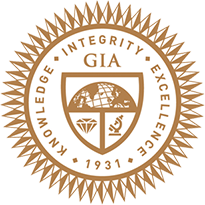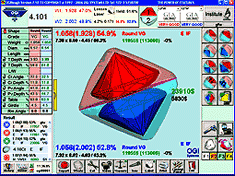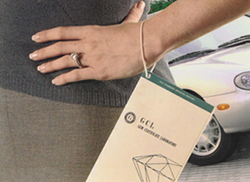 |
 |

My name is Gary Wright.
I am a Graduate Gemologist GIA, a Registered Supplier and Certified Gemologist AGS and a member of the NY Diamond Dealers Club. I have made over 150 trips overseas to import diamonds since 1985. I have owned my own diamond importing and wholesale company for over thirty years and operate the Website www.HeartsandArrows.com. I’m known in the business as one who always has an opinion about issues in our industry and admittedly, I am not shy about saying something about them. Now I have a bigger forum to express myself, from time to time, about issues that face the jewelry industry...this is my Blog. Extra Facets expresses my opinion about issues that mean a great deal to me. I hope readers find value in my comments.
|
 |
Posted August 7, 2017 by Gary Wright |
 |

It was the best of times, it was the worst of times... Sounds like GIA’s fortunes the past decade or so. Read on...
Many years ago GIA operated a small operation in just two cities located in California and New York. Life was good and GIA ran a tight ship! Grading was reliable and accurate and folks normally accepted GIA grading as the pinnacle of accuracy in diamond grading. And so it was for decades, until rapid expansion started happening. It seems GIA realized they had “a recipe for printing money”! In a short span of time, labs were springing up all over the globe: India, Thailand, Hong Kong, Botswana, South Africa, Japan and Israel. Nine labs & hundreds of employees later, GIA was no longer as “spot on” with their grading as once thought! They seem to have lost control! It became important to know what city the diamond was graded in, but this was impossible as their report numbering system is totally random. So now that much business is done chiefly from comparing and analyzing GIA Reports remotely and not by “old school” methods of examining diamonds under magnification and comparing to Master sets, it has made diamond buying more risky. The idea of just comparing “apples & apples” when buying diamonds with GIA Reports and letting prices of these diamonds be the final arbiter, may be a fool’s errand. Does this mean that the GIA report in your hand is not accurate? Maybe not, but it might be, which is the real issue. Like a broken watch that’s still accurate twice a day, it’s still not very useful! GIA is running consumer ads in magazines worldwide touting their reliability, which doesn’t make them more reliable, just well known! No one wants to admit the GIA might not be accurate! You may not hear this from diamond suppliers or Websites selling diamonds to the unsuspecting public. GIA reports have always been a type of “Sacred Cow” in our industry, but in the light of “total transparency” that we hear so much about today, perhaps it’s time to put a knife to it. We love GIA as an institution and will still offer GIA reports of course, but we employ the same standards we’ve used for three decades to examine them. When buying any diamond with a GIA grading report or any lab report, we recommend what President Reagan advised, “Trust, but verify!”
Gary W. Wright GG GIA
|
|
 |
Posted October 11, 2007 by Gary Wright |
 |
 Today's young shopper wants The Next Thing! He buys HD TV, the latest video I-pod, the newest phone with all the toys. He will pay top dollar for New Technology. Could you see this guy buying a CRT monitor or any other "throw-back" technology from the last millennium? Young "dialed-in" buyers won't settle for old school technology, so why should they settle for a 20th century diamond. The answer is simple. They don't know! So why do jewelers still offer diamonds cut to the mediocre standards of the last generation, when today we have far more choices? Today's young shopper wants The Next Thing! He buys HD TV, the latest video I-pod, the newest phone with all the toys. He will pay top dollar for New Technology. Could you see this guy buying a CRT monitor or any other "throw-back" technology from the last millennium? Young "dialed-in" buyers won't settle for old school technology, so why should they settle for a 20th century diamond. The answer is simple. They don't know! So why do jewelers still offer diamonds cut to the mediocre standards of the last generation, when today we have far more choices?
New Technology
It is important to point out to tech savvy consumers that H&A Ideal cut diamonds are something "totally new" and totally high tech! These New Age diamonds were designed with CAD technology from the rough, cut by computer driven cutting wheels, graded and quantified by sophisticated computer models that measure brilliance, scintillation and light performance. These incredible diamonds born of the computer age...are not your father's diamonds.
It is important to point out to today's customer, that if they settle for an ordinary diamond, they are not taking advantage of state of the art cutting and in fact, are looking to OLD technology?
There have always been 1-2-3ct diamonds, we've always had D colors & H colors, always had Flawless, VS etc., but never before have diamonds been cut like this. Tell them, "If you have to compromise on anything, to fit a budget, drop from G to H color, go down one clarity grade, drop from 2 to 1/12ct, etc...but don't compromise on beauty!"
Unlike the buyers of the past, they don't have to except inferior cutting anymore. We have more choices today! This 21st century diamond was not available when their father was shopping for a diamond, years ago. Times have changed.
Hearts and Arrows Ideal Cut diamonds...the art of diamond cutting, perfected. |
|
 |
Posted October 11, 2007 by Gary Wright |
 |
 In 1979, when I first entered the business, GIA reports were not widely used.
Diamonds were being sold as investments then and most "certs" were done only on "high-end stones". If you had a high color, VS2 or better stone over .50ct, the market demanded "a paper". SI goods and smaller sizes were sold with jewelry store or supplier grades. As the public became more aware of GIA reports they started asking for them. Around this time, the "second tier" labs EGL, IGI, and finally HRD became players, albeit their standards were seen as "looser than GIA". These labs undercut GIA's pricing; offered "mini-certs", low price consultations and faster turnaround times at their labs. Sellers also learned that because of the lenient grading standards from some of these foreign labs they could make bigger margins and in turn sell their goods at larger discounts then GIA graded diamonds. In 1979, when I first entered the business, GIA reports were not widely used.
Diamonds were being sold as investments then and most "certs" were done only on "high-end stones". If you had a high color, VS2 or better stone over .50ct, the market demanded "a paper". SI goods and smaller sizes were sold with jewelry store or supplier grades. As the public became more aware of GIA reports they started asking for them. Around this time, the "second tier" labs EGL, IGI, and finally HRD became players, albeit their standards were seen as "looser than GIA". These labs undercut GIA's pricing; offered "mini-certs", low price consultations and faster turnaround times at their labs. Sellers also learned that because of the lenient grading standards from some of these foreign labs they could make bigger margins and in turn sell their goods at larger discounts then GIA graded diamonds.
As the time went on, more retailers started pushing "certs" from many different labs, telling buyers that they needed a lab report to protect them from misrepresentation by "unscrupulous" retailers or investment houses.
At this same time, the Rapaport price list began to add structure to wholesale asking prices and price differences between grades became more standardized. Small differences in one color or clarity grade could add up to 15% -50% or more. A buyer who bought a one carat stone graded H rather than a G would pay 15% less. A buyer who bought the same size in an I1 rather than a SI2 might pay 50% less. However, if the "certificate" was inflated by the same grade differences i.e. the stone graded G VS2 was really an H VS2 or that G SI2 should actually be graded as G I1, then that consumer would have overpaid by 15% or 50% respectively. For the most part, sellers told their customers "not to worry". Consumers were assured that the labs are independent and "do not buy or sell". Buyers could feel confident buying a diamond with a lab report rather than trusting a jeweler's grade. This made "good sense" to the public and therefore they continued to buy diamonds with assurance that the jeweler was not able to inflate the grade and overcharge them. For decades now this story has continued...
Gem Labs don't buy or sell?
But wait a minute; let's look at this rationale. Don't gem labs indeed sell? In fact, they do. They sell their products/services to the trade and take in tens of millions of dollars a year. They sell their lab reports to dealers and jewelers by offering superior service, lower prices, faster wait times and last but not least, easier grading standards.
If a dealer has a 1 ct diamond that he thinks is an H SI1, he might expect to sell it at the going price for H SI1 diamonds. But, if the Lab gives him G VS2 on the report he could sell it for $1500 more. This could triple his profit! All thanks to this independent lab report. Now are all these dealers and gem labs dishonest? No! Some are just not knowledgeable. Some are blissfully ignorant and don't really want to know the truth. Some have never learned the GIA grading standards that go along with the GIA nomenclature. Finally, some of these reports, even those issued by highly respected labs such as GIA or AGS, might just be wrong. After all, people grade diamonds and people can make mistakes. GIA has a disclaimer on every report they issue, "this report is not a guarantee...". Most GIA and AGS reports are "dead on" and very reliable, but some are not and this could make big differences in the price of the diamond. We have looked at thousands of "certified" diamonds over the years and we can testify that many of them are "borderline" and a lot of them were incorrectly graded and some by more than one grade. We have seen some second tier grading reports that were off 4-5 grades! How does this protect the consumer?
A Russian roulette of diamond buying
Let's face it; we live in a litigious society, where the courts put consumer protection at a high priority. Consumers who put their trust in gemological reports do so because jewelers have assured them that it is going to protect them from being ripped off by jewelers' lax grading. Hundreds of diamonds per day are being sold in stores across the globe. Internet sites have created whole businesses around selling diamonds based on their lab reports. What have we created? How many of them are overpaying or buying a diamond that is priced fairly, but misrepresented to make the seller look good? Some buyers are lucky and are buying a correctly graded diamond. Some of them are not so lucky. A kind of Russian roulette of diamond buying.
Should people go back to buying non-certified goods?
So you might ask, "What is the point you are making here?" Should people go back to buying non-certified goods? Perhaps. It is unlikely that this will ever happen, because the industry is so invested in the current way of doing things. After all, it is easy. Put all the burden of responsibility on the labs and blame them if there is a problem. The jeweler is off the hook, right? Wrong! The point is, our industry has taken the easy way out and has not taken responsibility for what we are doing or for the importance of educating our customers or ourselves. We need to go back to the days of grading diamonds using gemological methods, tools and skill. Only then can one be sure! Reliance on someone else's opinion in absence of our own, is not only lazy, it is irresponsible.
Stop buying Paper and start looking at the stone!
The answer is not an easy one, "trust, but verify". It all comes back to looking at diamonds again. The old days of the "Double A, Triple A, Blue White Perfect" grades are history. Everyone today uses the GIA nomenclature, which is a good thing, but that is only the start. Consumers should consult a credentialed jeweler or gemologist about the importance and interrelationship of cut, color, clarity and carat weight. They should ask to see the diamonds next to a GIA or AGS graded Color Master diamond set of at least four stones. They should compare clarities of diamonds against similarly graded ones from GIA (under 10x magnification), especially if the diamond is coming from a "second tier" lab. If the diamond seems "off", consumers might want to have the diamond verified by an AGS certified Appraiser or other independent appraiser. Quite often the reaction of the seller to this request is enough proof of doubt.
The trend towards buying and selling paper and turning certified diamonds into a commodity bought with "blind faith" is bad news! It will turn the diamond business over to mass marketers, websites and the unscrupulous. No one should buy a diamond based only upon the grading report alone. Isn't it ironic? The very same "certificate" that consumers thought would protect them from buying an over-graded diamond, has now become the problem, not the cure.
|
|
 |
|
 |
 |
 |
|




















